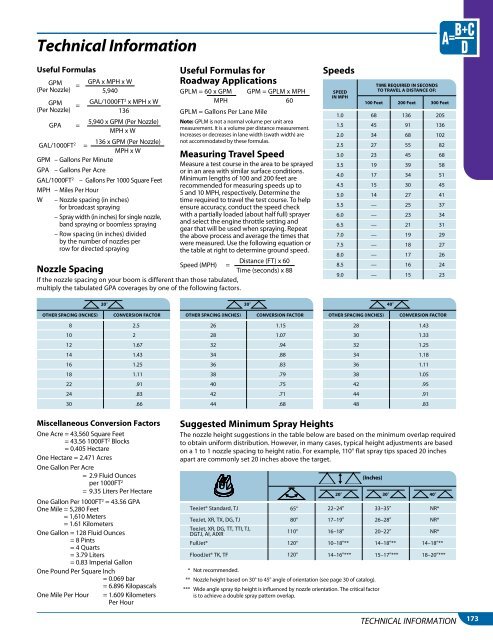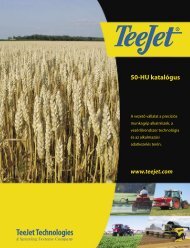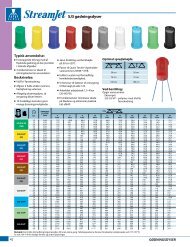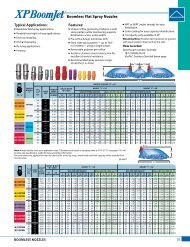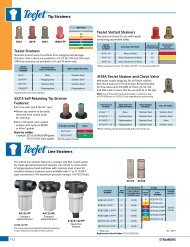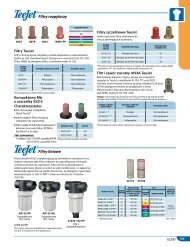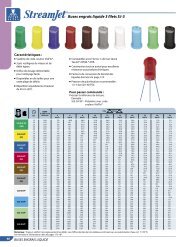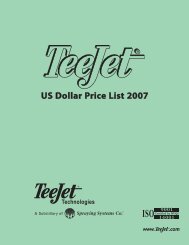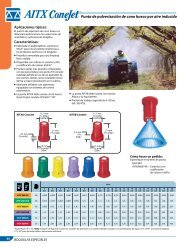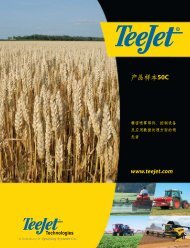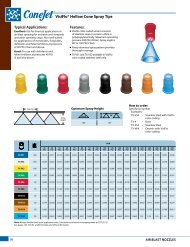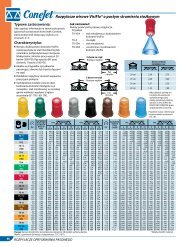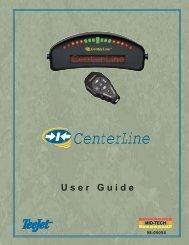You also want an ePaper? Increase the reach of your titles
YUMPU automatically turns print PDFs into web optimized ePapers that Google loves.
Technical InformationUseful FormulasGPM GPA x MPH x W=(Per Nozzle) 5,940GPM GAL/1000FT 2 x MPH x W=(Per Nozzle) 136GPA =5,940 x GPM (Per Nozzle)MPH x W136 x GPM (Per Nozzle)GAL/1000FT 2 =MPH x WGPM – Gallons Per MinuteGPA – Gallons Per AcreGAL/1000FT 2 – Gallons Per 1000 Square FeetMPH – Miles Per HourW – Nozzle spacing (in inches)for broadcast spraying– Spray width (in inches) for single nozzle,band spraying or boomless spraying– Row spacing (in inches) dividedby the number of nozzles perrow for directed sprayingUseful Formulas forRoadway ApplicationsNozzle SpacingIf the nozzle spacing on your boom is different than those tabulated,multiply the tabulated GPA coverages by one of the following factors.GPLM = 60 x GPM GPM = GPLM x MPHMPH 60GPLM = Gallons Per Lane MileNote: GPLM is not a normal volume per unit areameasurement. It is a volume per distance measurement.Increases or decreases in lane width (swath width) arenot accommodated by these formulas.Measuring Travel SpeedMeasure a test course in the area to be sprayedor in an area with similar surface conditions.Minimum lengths of 100 and 200 feet arerecommended for measuring speeds up to5 and 10 MPH, respectively. Determine thetime required to travel the test course. To helpensure accuracy, conduct the speed checkwith a partially loaded (about half full) sprayerand select the engine throttle setting andgear that will be used when spraying. Repeatthe above process and average the times thatwere measured. Use the following equation orthe table at right to determine ground speed.Distance (FT) x 60Speed (MPH) =Time (seconds) x 88SpeedsSpeedin MPHTime Required in SECONDSto Travel a Distance of:100 Feet 200 Feet 300 Feet1.0 68 136 2051.5 45 91 1362.0 34 68 1022.5 27 55 823.0 23 45 683.5 19 39 584.0 17 34 514.5 15 30 455.0 14 27 415.5 — 25 376.0 — 23 346.5 — 21 317.0 — 19 297.5 — 18 278.0 — 17 268.5 — 16 249.0 — 15 23209Other Spacing (Inches) Conversion Factor8 2.510 212 1.6714 1.4316 1.2518 1.1122 .9124 .8330 .66309Other Spacing (Inches) Conversion Factor26 1.1528 1.0732 .9434 .8836 .8338 .7940 .7542 .7144 .68409Other Spacing (Inches) Conversion Factor28 1.4330 1.3332 1.2534 1.1836 1.1138 1.0542 .9544 .9148 .83Miscellaneous Conversion FactorsOne Acre = 43,560 Square Feet= 43.56 1000FT 2 Blocks= 0.405 HectareOne Hectare = 2.471 AcresOne Gallon Per Acre= 2.9 Fluid Ouncesper 1000FT 2= 9.35 Liters Per HectareOne Gallon Per 1000FT 2 = 43.56 GPAOne Mile = 5,280 Feet= 1,610 Meters= 1.61 KilometersOne Gallon = 128 Fluid Ounces= 8 Pints= 4 Quarts= 3.79 Liters= 0.83 Imperial GallonOne Pound Per Square Inch= 0.069 bar= 6.896 KilopascalsOne Mile Per Hour = 1.609 KilometersPer HourSuggested Minimum Spray HeightsThe nozzle height suggestions in the table below are based on the minimum overlap requiredto obtain uniform distribution. However, in many cases, typical height adjustments are basedon a 1 to 1 nozzle spacing to height ratio. For example, 110° flat spray tips spaced 20 inchesapart are commonly set 20 inches above the target.(Inches)<strong>TeeJet</strong>® Standard, TJ<strong>TeeJet</strong>, XR, TX, DG, TJ<strong>TeeJet</strong>, XR, DG, TT, TTI, TJ,DGTJ, AI, AIXRFullJet®FloodJet® TK, TF65°80°110°120°120°22–24917–19916–18910–189**14–169***33–35926–28920–22914–189**15–179***NR*NR*NR*14–189**18–209**** Not recommended.** Nozzle height based on 30° to 45° angle of orientation (see page 30 of catalog).*** Wide angle spray tip height is influenced by nozzle orientation. The critical factoris to achieve a double spray pattern overlap.209 309 409TECHNICAL INFORMATION173


